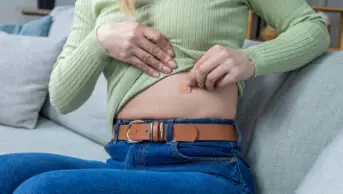
Adrià Voltà
“Everything’s wrong about it. It’s the cost. It’s the potential for overuse because it’s very hard to measure out. It’s the potential for underuse because you’re conservative and you might use less,” says Susan Davis, an endocrinologist at Monash University in Melbourne, Australia, as she spells out the problems arising from the lack of a licensed female-specific testosterone product in the UK for post-menopausal women.
Instead, women seeking to treat symptoms such as distressing low libido must use formulations designed for men, which contain much higher doses of the hormone. “Women only need between 5–10% of the male dose and more often it’s 5% or even less,” says Michael Buckley, a pharmacist and chief executive of Lawley Pharmaceuticals in Western Australia, which has developed Androfeme, a female-specific testosterone cream that was licensed throughout Australia in 2020 (see Box).
This lack of a UK-licensed product means women are finding it hard to get testosterone treatment on the NHS. GPs are often reluctant to prescribe male formulations off-label and, even if they are prescribed, they are not covered by the hormone replacement therapy (HRT) pre-payment certificate, which is due to start in England in April 2023. Specialist NHS menopause clinics can prescribe testosterone but are overwhelmed by demand, driven in part by a surge of public awareness about menopause treatments.
This demand is reflected in the rise in the number of women prescribed testosterone gel on the NHS that has occurred in recent years. On 17 February 2023, data analysis by The Pharmaceutical Journal revealed there has been around a ten-fold increase in the number of women prescribed testosterone over the past seven years, with the steepest rise happening after the airing of UK TV personality Davina McCall’s documentaries about the menopause in 2021 and 2022 (see Figure).
The NHS data, obtained through a Freedom of Information request, revealed a 52% rise in women aged 50 years and over taking testosterone in May 2022, coinciding with the broadcast of McCall’s second documentary, which included information about testosterone treatment.
Women are coming in their droves, general practice is on its knees, and the only place for those women to go is privately
Paula Briggs, consultant in sexual and reproductive health and chair of the British Menopause Society
“Women are coming in their droves,” says Paula Briggs, consultant in sexual and reproductive health at Liverpool Women’s NHS Foundation Trust and chair of the British Menopause Society. “General practice is on its knees. And the only place for those women to go is privately. And the number of private clinics has absolutely exploded.”
Private menopause clinics can offer Androfeme, imported under a special licence from the Medicines and Healthcare products Regulatory Agency (MHRA), but this can be expensive, priced at approximately £100 for a 100-day supply. What’s more, clinicians allege that some private clinics are offering testosterone for other indications for which there is no firm evidence.
Benefits of testosterone
Testosterone has a reputation for being a ‘male’ hormone, but women also produce it. Unlike oestrogen, there is no sharp drop-off at menopause; instead, levels decline throughout the reproductive years, reaching their lowest point when a woman is in her early 60s, before rising again to premenopausal levels in her 70s and beyond[1,2].
Much remains to be learned about what role testosterone plays in female physiology. Observational studies have shown correlations between higher testosterone levels and improved cardiovascular health, higher bone density and a lower risk of hip fracture in post-menopausal women[3]. Lower levels in women aged over 70 years are associated with an increased risk of ischaemic cardiovascular problems, such as stroke or heart attack[4]. However, it is not clear whether these relationships are causative or whether testosterone levels are merely a biomarker for other factors, such as adrenal function or general health, says Davis.
A lot of people ascribe cause and effect and then make the dangerous jump that treatment might be beneficial
Susan Davis, an endocrinologist at Monash University in Melbourne, Australia
“A lot of people ascribe cause and effect and then make the dangerous jump that treatment might be beneficial,” she says. “Treatment’s only beneficial if you show it’s beneficial.”
The one undisputed benefit of supplementing testosterone in women is treating distressing post-menopausal low libido, be it natural menopause or menopause induced by surgery to remove the ovaries. The condition, known as hypoactive sexual desire disorder (HSDD) is characterised by a loss of sexual fantasies and sexual desire, which causes personal distress[5].
In 2019, Davis and colleagues performed a systematic review and meta-analysis of clinical trial data and concluded that the evidence supporting testosterone’s use to treat HSDD was clear[6]. The team found no evidence of benefit for treating other post-menopausal symptoms, such as low mood, depression, cognitive function, bone density or muscle strength, but noted that some of these trials were too small or too short to be conclusive[3].
In light of these findings, global experts and learned societies convened to develop a global consensus position statement on the use of testosterone in women, which was published in 2019[7]. It aimed to provide clear guidance on the use of the therapy, including recommendations on clinical care, and concluded that the only evidence-supported indication currently was HSDD.
The position statement informed the 2022 guidelines produced by the British Menopause Society for GPs and other healthcare professionals, which state that testosterone should only be offered to post-menopausal women with low sexual desire and only after other potential causes, such as relationship problems, have been excluded[8]. They say a trial of conventional HRT should be offered first.
Misinformation
Women’s sexuality is complex and the correct diagnosis of HSDD takes time — careful assessment of other factors affecting sex drive need to be considered before prescribing testosterone. “It’s very easy to think, ‘Oh, my sex drive is down because of the menopause,’ and it may well be,” says Debra Holloway, a nurse consultant in gynaecology and a specialist in menopause at Guys and St Thomas’s NHS Foundation Trust in London. “But if you’ve had years of ill health, that will play a part, and trying to treat something that isn’t related to hormones with a hormone obviously doesn’t work.”
However, Briggs and other clinicians say they are aware of women being offered testosterone outside of the recommended indication of HSDD in private clinics. “There’s a lot of practice outside of guidelines now and guidelines are there for patient safety reasons,” says Briggs. Some of the pressure to do so comes from patients, who are reacting to recent publicity and developing unrealistic expectations of HRT and testosterone.
There’s misinformation out there that you can take it and you’ll feel absolutely wonderful
Debra Holloway, a nurse consultant in gynecology and a specialist in menopause at Guys and St Thomas’s NHS Foundation Trust
“There’s misinformation out there that you can take it and you’ll feel absolutely wonderful,” adds Holloway. “And that’s not necessarily the case.”
Testosterone is normally added to conventional HRT, which itself can also help to boost libido, but it is not guaranteed to work. “Testosterone clearly works for some women really well, but it doesn’t for all women,” says Briggs. It is important to measure a woman’s baseline testosterone levels, she adds, to make sure they are indeed low and would not be pushed out of the normal range by treatment. If it is going to work, it normally does so after between four and six weeks. “I usually say to women, if you haven’t had a response by six months and your bloods are showing that we’ve got the levels right, there’s no point in pursuing this,” says Briggs.
On potential side effects, the position statement says that systemic testosterone therapy for post-menopausal women, in doses that approximate physiological testosterone concentrations for premenopausal women, is associated with mild increases in acne and body or facial hair growth in some women, but not with alopecia, clitoromegaly or voice change. It also states that available data suggest short-term transdermal testosterone therapy does not impact cardiovascular or breast cancer risk, although insufficient data are available to assess long-term risk, and women at high cardiometabolic risk were excluded from study populations.
Licensed product
The 2019 position statement also highlighted “a pressing need” for the development and licensing of products specifically for women. While doctors in Australia can prescribe Androfeme, in the UK and other countries, women have to muddle through with male testosterone products, such as Tostran (Kyowa Kirin), Testim (Endo Ventures) and Testogel (Besins Healthcare UK). This makes it difficult for women to measure their dose correctly. One pump of Testogel, for example, delivers nearly three times the dose a woman needs. What’s more, sachets of gel are alcohol-based and, once opened, the alcohol evaporates, concentrating the dose.
Buckley is in the process of modifying the dossier he used to get Australian approval for Androfeme to present to the MHRA, which he plans to do in the near future. Owing to the financial commitment involved in making an application, he says this will be a one shot. “We’re just a little tiny pharmaceutical company, but the UK is important to us,” he says.
The rest of the world will be watching what happens in the UK
Michael Buckley, a pharmacist and chief executive of Lawley Pharmaceuticals
Buckley says the UK’s regulatory system is considered robust. “The rest of the world will be watching what happens in the UK,” he believes. He has talked to people in other companies. “Everyone’s holding their breath because they don’t want to take the risk.”
If licensed by the MHRA, the next hurdle would be getting Androfeme onto the formularies of recommended medicines within individual integrated care boards and health boards. “There’s some work [that needs to be done] generally on HRT, making sure it’s standardised and making sure that you have access, no matter where you are, to the right products,” says Holloway.
Other indications
The historical research focus on HSDD means that other potential indications for testosterone replacement in women still need to be fully investigated. Davis is currently recruiting women for a study into the effects of testosterone on bone, as well as sexual function in younger women. She is also about to start a study on heart failure, as well as two large studies: one looking at muscle and the other looking at whether there is any relationship between testosterone and cognitive decline[9].
Meanwhile, in the UK, the National Institute for Health and Care Research put out a call in December 2022 for studies to “increase the evidence base for testosterone as a treatment for menopause symptoms beyond altered sexual function”[10].
Developing an evidence-based approach is particularly important given the current enthusiasm for HRT, which some clinicians worry has morphed into over-enthusiasm.
“There’s a lot of pressure on women now to have HRT,” says Briggs. “There’s a lot of stuff that is making women quite frightened — they’re frightened about feeling suicidal, their marriage breaking down or [about] getting osteoporosis.
“We need to just calm down, [and] make sure women have had the right information on which to base a choice.”
Box: Testosterone’s approval saga
Although doctors have been treating women with testosterone since the 1940s, getting a female-specific formulation approved by regulators has been an uphill struggle.
In 2004, Proctor and Gamble (P&G) applied to the US Food and Drug Administration (FDA) for approval for Intrinsa (Warner Chilcott), a patch for women with hypoactive sexual desire disorder who had undergone surgical menopause that delivered a daily dose of 300 micrograms of testosterone through the skin. While agreeing the patch was clinically effective, the panel cited a lack of long-term safety data as a reason for rejecting the application[11].
In 2006, the company succeeded in getting Intrinsa approved by the European Medicines Agency (EMA) for the same indication. Three years later, having undertaken further clinical trials, it applied to extend the indication to women with HSDD who had undergone a physiological menopause. The EMA refused, stating that long-term safety data were considered limited and not robust enough to support a positive risk/benefit balance in the target population, which was considerably larger than the population for which it was originally authorised[12]. The patch was eventually withdrawn from the market altogether[13].
The most recent attempt to get a product approved was made by BioSante Pharmaceuticals, whose trials of a testosterone gel called Libigel initially foundered because of an unexpectedly high placebo effect, and then ended in 2011 because of a lack of funding[14].
The timing of P&G’s applications may have had a bearing on the regulators’ caution. In 2004, the FDA’s approval process was under public scrutiny in the wake of the Vioxx (rofecoxib; Merck) scandal, in which the analgesic was found to cause an increase in dangerous cardiovascular events, such as strokes and heart attack[15,16]. Two years previously, the Women’s Health Initiative, a large, randomised study of oestrogen/progestin HRT, published its first results, which suggested the risks of HRT outweighed its benefits. Subsequent analysis showed these risks were overblown, but the reputation stuck[17]. This may also have made regulators especially wary of approving treatments involving sex hormones[18].
However, critics of the regulators’ responses have pointed out that this caution did not extend to testosterone treatments for men, which were approved without the same need for extensive safety data[19]. By 2020, 31 products were approved by the FDA for men; none for women[14].
“It occurs to me that this apparent double standard may reflect differing values placed on the importance of sexual health in women versus men,” Sheryl Kingsberg, an expert on female sexual dysfunction who was one of the lead investigators for the Intrinsa trials, wrote in 2005, shortly after the FDA’s rejection[19].
While this was all going on, Michael Buckley, founder and chief executive of Lawley Pharmaceuticals, was developing Androfeme. He started producing the cream in 1999 and, thanks to a quirk of Australia’s older state-based medicines regulatory system, was able to supply Androfeme to Western Australia-based pharmacies for dispensing both locally and to women all over Australia by mail order.
After two attempts to get Androfeme licensed throughout the country by Australia’s Therapeutic Goods Administration (TGA), Buckley’s third try in 2019 was successful, partly thanks to publication of the meta-analysis paper by Susan Davis and her colleagues, partly thanks to his own data collection. “We had 20 years of data in over 9,000 Australian patients, some of whom had used it for over 12 years,” he says. Androfeme received TGA approval in 2020 and is now licensed nationwide in Australia.
- 1Davison SL, Bell R, Donath S, et al. Androgen Levels in Adult Females: Changes with Age, Menopause, and Oophorectomy. The Journal of Clinical Endocrinology & Metabolism. 2005;90:3847–53. doi:10.1210/jc.2005-0212
- 2Davis SR, Bell RJ, Robinson PJ, et al. Testosterone and Estrone Increase From the Age of 70 Years: Findings From the Sex Hormones in Older Women Study. The Journal of Clinical Endocrinology & Metabolism. 2019;104:6291–300. doi:10.1210/jc.2019-00743
- 3Davis SR. Testosterone for women: certainties and uncertainties. Climacteric. 2022;26:21–4. doi:10.1080/13697137.2022.2146492
- 4Islam RM, Bell RJ, Handelsman DJ, et al. Associations between blood sex steroid concentrations and risk of major adverse cardiovascular events in healthy older women in Australia: a prospective cohort substudy of the ASPREE trial. The Lancet Healthy Longevity. 2022;3:e109–18. doi:10.1016/s2666-7568(22)00001-0
- 5Parameshwaran S, Chandra PS. The New Avatar of Female Sexual Dysfunction in ICD-11—Will It Herald a Better Future? Journal of Psychosexual Health. 2019;1:111–3. doi:10.1177/2631831819862408
- 6Islam RM, Bell RJ, Green S, et al. Safety and efficacy of testosterone for women: a systematic review and meta-analysis of randomised controlled trial data. The Lancet Diabetes & Endocrinology. 2019;7:754–66. doi:10.1016/s2213-8587(19)30189-5
- 7Davis SR, Baber R, Panay N, et al. Global Consensus Position Statement on the Use of Testosterone Therapy for Women. The Journal of Clinical Endocrinology & Metabolism. 2019;104:4660–6. doi:10.1210/jc.2019-01603
- 8British Menopause Society. Testosterone replacement in menopause. British Menopause Society. 2022.https://thebms.org.uk/wp-content/uploads/2022/12/08-BMS-TfC-Testosterone-replacement-in-menopause-DEC2022-A.pdf (accessed 13 Mar 2023).
- 9New study to see whether a skin cream can prevent heart failure in women. Monash University. 2022.https://www.monash.edu/medicine/news/latest/2022-articles/new-study-to-see-whether-a-skin-cream-can-prevent-heart-failure-in-women (accessed 13 Mar 2023).
- 1022/170 Testosterone for the treatment of menopause symptoms beyond altered sexual function commissioning brief. National Institute for Health and Care Research. 2022.https://www.nihr.ac.uk/documents/22170-testosterone-for-the-treatment-of-menopause-symptoms-beyond-altered-sexual-function-commissioning-brief/31951 (accessed 13 Mar 2023).
- 11Moynihan R. FDA panel rejects testosterone patch for women on safety grounds. BMJ. 2004;329:1363.1. doi:10.1136/bmj.329.7479.1363
- 12Warner Chilcott UK Ltd withdraws its application for an extension of indication for Intrinsa . European Medicines Agency. 2010.https://www.ema.europa.eu/en/documents/press-release/warner-chilcott-uk-ltd-withdraws-its-application-extension-indication-intrinsa_en.pdf (accessed 13 Mar 2023).
- 13Withdrawal assessment report for Intrinsa. European Medicines Agency. 2010.https://www.ema.europa.eu/en/documents/withdrawal-report/withdrawal-assessment-report-intrinsa_en.pdf (accessed 13 Mar 2023).
- 14Simon JA, Kapner MD. The Saga of Testosterone for Menopausal Women at the Food and Drug Administration (FDA). The Journal of Sexual Medicine. 2020;17:826–9. doi:10.1016/j.jsxm.2020.01.009
- 15Lenzer J. FDA is incapable of protecting US “against another Vioxx”. BMJ. 2004;329:1253. doi:10.1136/bmj.329.7477.1253
- 16Moynihan R. Drug maker urges group to lobby FDA on testosterone for women. BMJ. 2004;329:1255.1. doi:10.1136/bmj.329.7477.1255
- 17Cagnacci A, Venier M. The Controversial History of Hormone Replacement Therapy. Medicina. 2019;55:602. doi:10.3390/medicina55090602
- 18Spark RF. Intrinsa fails to impress FDA advisory panel. Int J Impot Res. 2005;17:283–4. doi:10.1038/sj.ijir.3901308
- 19Kingsberg SA. The testosterone patch for women. Int J Impot Res. 2005;17:465–6. doi:10.1038/sj.ijir.3901375


